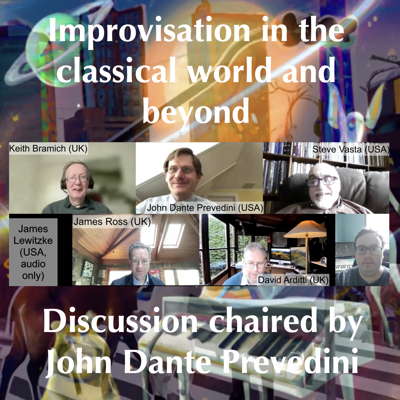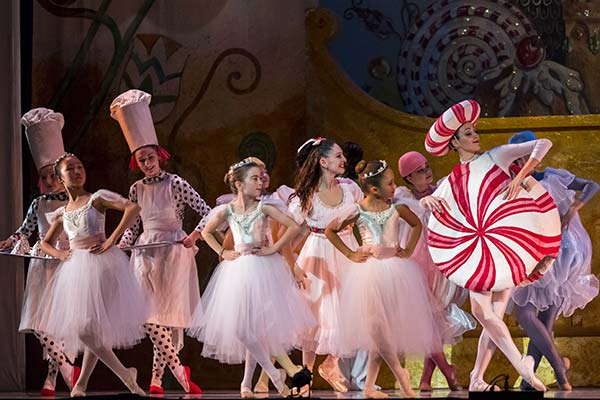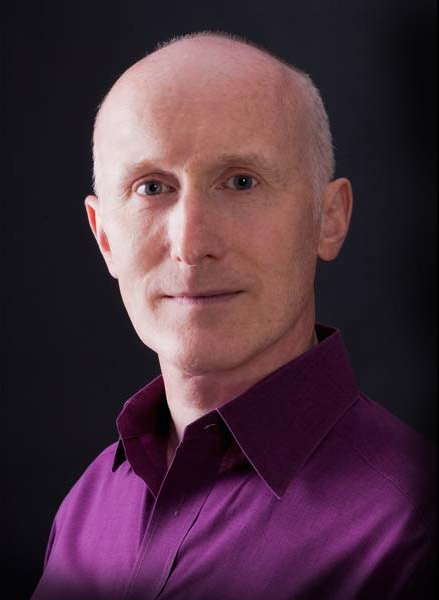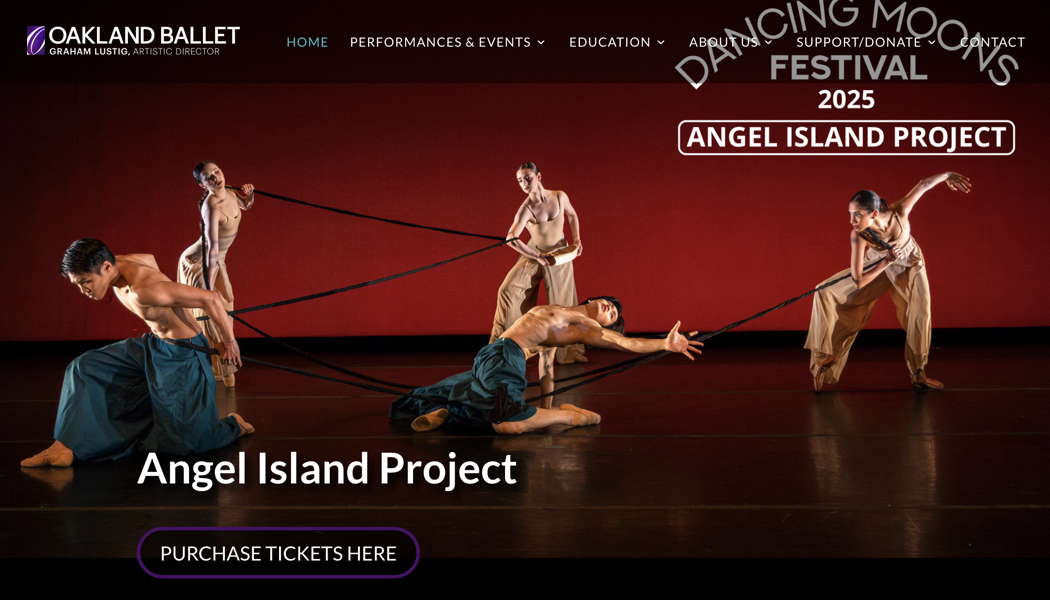- Thomas Allen
- BBC Philharmonic
- Brenda Lewis
- Scarlatti
- Polanski
- Layla Claire
- Beethoven: An die Ferne Geliebte
- Michael John Haden: Hymn to Love
 FEEDBACK: She said WHAT? Read what people think about our Classical Music Daily features, and have your say!
FEEDBACK: She said WHAT? Read what people think about our Classical Music Daily features, and have your say!
 DISCUSSION: John Dante Prevedini leads a discussion about Improvisation in the classical world and beyond, including contributions from David Arditti, James Lewitzke, James Ross and Steve Vasta.
DISCUSSION: John Dante Prevedini leads a discussion about Improvisation in the classical world and beyond, including contributions from David Arditti, James Lewitzke, James Ross and Steve Vasta.
Individual and Communal Transformation

JEFFREY NEIL talks to Oakland Ballet's artistic director, Graham Lustig
When I mentioned to a friend, who is a retired singer and dancer, that I was going to the ballet, she asked, 'San Francisco or Oakland?' I told her I was attending 'Graham Lustig's The Nutcracker' to which she responded, 'I love Oakland Ballet. They have soul.' For her, it was not just about the performance, but the work they do in the community, such as their workshops at the children's hospital where she was a physical therapist.

Student auditions for Nutcracker at Oakland Ballet
This was my second time enjoying The Nutcracker at the Paramount Theater and my first time talking to artistic director of the Oakland Ballet Company, Graham Lustig. It is altogether a different experience from the production at The War Memorial Opera House where patricians sit in seats that typically cost several hundred dollars and go up to over a grand. Director Graham Lustig's charming production has its own spin, as in his unique addition of the dancing snowballs to Act I's concluding scene, 'In the Frozen Forest'. His choreography of 'Coffee' departs from classical ballet in a sultry interpretation that highlights the submerged eroticism in the source texts that inspired Tchaikovsky.
Graham Lustig has tried to make the ballet not just entertaining - indeed not just relevant - but also an experience that turns the audience into participants. Lustig sends dancers to lead workshops at schools and hospitals where people can experience classical music and other kinds of music with their own bodies, rather than obediently wedged into chairs to gawk at professional ballerinas.
I talked to director Lustig last December about forthcoming productions for this spring. We discussed his vision for the ballet in the post-pandemic reality of diminished audiences and stingier corporate donors. I asked him how he keeps the classical arts alive and cultivates younger aficionados. The native British choreographer described a head-spinning array of educational outreach and community programs.

Graham Lustig, who studied at the
Royal Ballet School in London UK,
has been artistic director
of Oakland Ballet since 2010
Lustig begins by sharing an exciting upcoming project entitled The Angel Island Project, set to premiere in May. 'Composer Huang Ruo was inspired by the poetry that was carved into the immigration station on Angel Island by Chinese immigrants.' He highlights how art can reclaim narratives and give a voice to otherwise forgotten immigrant experience. 'We're telling the stories of immigrants, and all of the artists participating are [Asian American Pacific Islander (AAPI)] artists who bring their own unique immigration perspective to the table,' Lustig emphasizes.

oaklandballet.org website screenshot showing The Angel Island Project
The Dancing Moons Festival, initiated in 2022, serves as another platform for showcasing AAPI creatives. Lustig noted that this festival is 'the first program of its kind in this country and has been recognized with an Isadora Duncan Award'. Through this festival, the ballet company celebrates cultural diversity and fosters community involvement.
One of the challenges Lustig faced upon taking the helm in 2010 was rebuilding the reputation of the Oakland Ballet. 'It was time to rebuild the organization ... rebrand if you like', Lustig recalls. This rebuilding effort involved significant outreach, particularly with local schools. With over eight thousand students benefiting from the Oakland Ballet's free education each year, Lustig emphasizes, 'I want to ensure that what we're doing on stages is available for the students'. The free dress rehearsal performances serve as a unique entry point for young audiences, many of whom are experiencing live ballet for the first time. Just one dress rehearsal for The Nutcracker brought in 'approximately 2600 students arriving for probably the very first time in a big theater ... and it is a working rehearsal insofar as if a tempo is wrong, I have to speak to the conductor, Pamela Martin, and say, "Oh, please play that a little slower or a little faster" '. To make it more interesting for the students, Lustig leaves the curtains open during the scene changes, 'so they can actually see the crew sweeping up the snow'. Engaging with students through tangible experiences, Lustig insists, 'We do a little bit of the story of The Nutcracker, and then we bring four students up on stage', offering practical exposure to dance.
Through various outreach initiatives, the Oakland Ballet aims to make the art form accessible to underrepresented communities. 'Practically every school in Oakland is a Title One school', Lustig explains, illustrating the need for sustained outreach efforts. The impact of such outreach can be profound. Lustig recalls the story of a student who, after participating in a performance, expressed a newfound understanding and connection: 'During your performance, I felt the spirit of my grandpa standing next to me'. This illustrates the type of meaningful connections that Lustig hopes to foster through the arts.
Lustig believes moments like this redefine the purpose of ballet beyond entertainment. 'The arts bring us together', he insists, enhancing community dialogue and understanding. When asked about the aesthetic and vision for productions, he shares, 'I want to do things that resonate', a guiding principle that honors both the dancers and the audience's experience. He recalls collaborating with local street dancers, 'I brought in two of those turf dancers, and they taught us their moves', showcasing how cross-genre collaboration invigorates the art form.
Educational outreach at Oakland Ballet takes multiple forms, from historical presentations about the art form in schools to specialized programs like You Can Dance. Lustig notes, 'We ask them to solve problems using movement', emphasizing the integration of creativity and physical expression. This program not only teaches students about dance but encourages them to explore their subjectivity and storytelling abilities. Lustig has plans to extend this educational ethos further with The Angel Island Project by developing a new presentation for schools that will educate students on the history of the immigration entry point, while showcasing some of the dances.
The future programming vision for the Oakland Ballet is not confined to traditional performances. Lustig's insights about the evolving landscape of ballet reveal a desire to embrace varied artistic influences. 'Today, the barrier, the fine line between what is ballet and what is not ballet, is ever more blurred', Lustig reflects. This acknowledgment of the fusion of styles speaks to his belief in the evolving nature of art forms, advocating for a broader interpretation of ballet that embraces contemporary influences. By integrating diverse dance styles and voices, the ballet becomes more relevant to contemporary audiences. Programs like their LGBTQ+ showcase, Rainbow Dances, reflect a growing understanding that ballet can encapsulate a multitude of expressions and experiences.
Looking toward the future, the Oakland Ballet will celebrate its sixtieth anniversary in 2025. Lustig mentions, 'We're planning a special anniversary performance', reflecting on both a celebration of history and a commitment to future innovations. The company's evolving relationship with its community, combined with a willingness to embrace new narratives and artists, positions it uniquely within the broader cultural landscape: 'I believe that the choreographers we are bringing in are creating dances that resonate and appeal both with the artists who are performing and the audiences that are coming'.
As the conversation draws to a close, Lustig reflects, 'The arts bring us to new understandings', and emphasizes that the experience of watching and participating in dance cultivates emotional expression that transcends the spoken word. He articulates a vision of the arts as a conduit for personal and communal growth. 'It's an opportunity for us to grow closer together and grow our hearts and understanding.' Lustig's insights underscore his belief that art is not merely a form of entertainment but a source of individual and communal transformation. As he aptly puts it, 'We want audiences not just to feel entertained; we want them to have moments of inspiration, moments of thought, moments of questioning as well'.
Copyright © 20 February 2025
Jeffrey Neil,
California, USA



